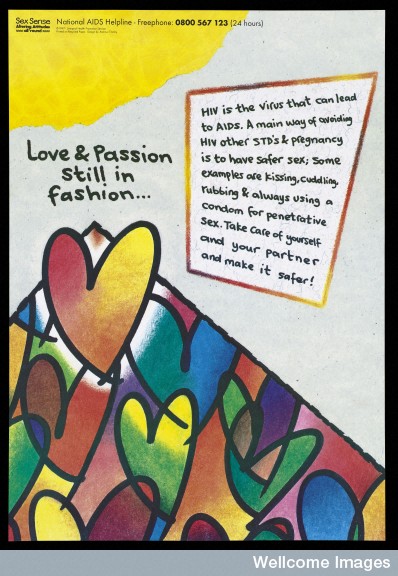Projects
The Placing the Public in Public Health project is made up of four sub-projects:
Image: Series of graphic hearts with a block of text about HIV and AIDS; an advertisement for the National Aids Helpline by the Liverpool Health Promotion Service, 1987. Wellcome Library, London.
1. The meaning of the public in health education/promotion
Alex Mold’s project will consider the changing conception of the public within attempts to educate the population and promote public health. Drawing on archival sources, oral history interviews and a rich seam of public health promotional material, including posters (such as the collection of 600 posters acquired recently by the Wellcome Library), leaflets and audio-visual sources, this project will analyse who the public were thought to be and how they were spoken to by public health.
2. Health surveys, public opinion and the public’s health
Daisy Payling’s project will examine the growth of the survey as a tool to both measure population health and to garner information about popular opinion of public health challenges and services. The history of the survey has attracted attention in recent years but few analysts have sought to examine the use of survey methods within post-war medicine, or looked at how the public were constituted through the survey and the ways in which it ‘spoke back’ to public health through such media.
3. Chronic disease: heart disease
Peder Clark’s project will consider the ways in which the public were constructed in the response to a major chronic illness and cause of morbidity and mortality in post-war Britain: coronary heart disease. Heart disease will act as a ‘tracer condition’ with which to explore the place of the public within the changing nature of public health, as attention shifted from infectious to chronic disease as the leading cause of morbidity and mortality.

Image: Wellcome polio vaccine dropped on sugar lump for child, c. 1980. Wellcome Library, London.
4. Infectious disease: vaccination and the public
Although the morbidity and mortality associated with infectious disease declined in Britain during the second half of twentieth century, communicable disease continued to be a major challenge for post-war public health. The public response to vaccination offers an excellent arena in which to observe the interaction between public health and the public. Gareth Millward is working on this project.
5. An Emotional Public? Public Health and the Public’s Emotions
Hannah Elizabeth is working with and within the four existing projects to begin to map out the ways in which emotion figures in British post-war public health and its relationship with the public. Addressing these questions will enhance the overall award by taking existing research and reading it through the lens of emotion as well as generating new material on emotions, the public and public health in post-war Britain.

